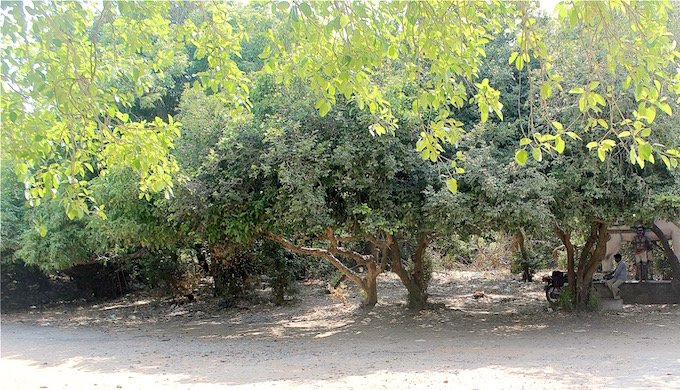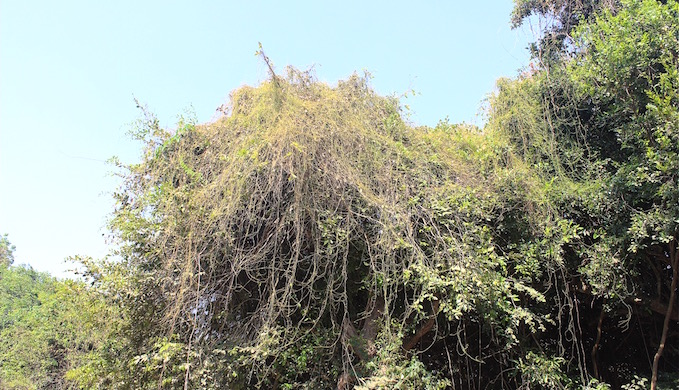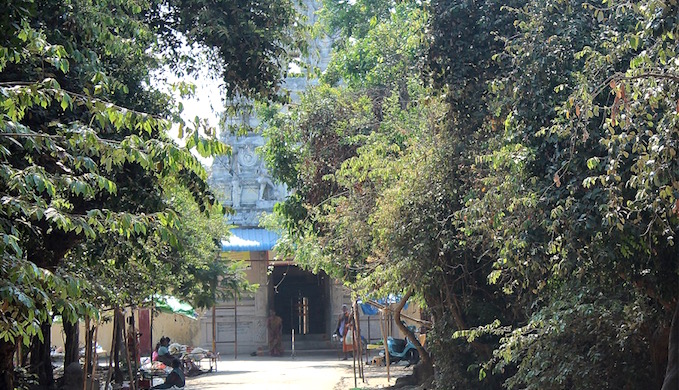The delicate balance of trees and vines has been disturbed in the tropical dry evergreen forests of India’s east coast, weakening their utility to local communities and their capacity to store carbon

The Puthupet sacred grove near Puducherry. (Photo by Vivek Pandian)
Local communities 10 km north of Puducherry on the east coast of India have for centuries preserved an anthill (puthu in Tamil) in a 17-hectare forest because they believed it was the abode of their snake god. Today the deity of Puthupet has a bigger, permanent abode in a temple.
But the forest – permanent abode of the trees – has no such refuge. The number of trees in Puthupet forest is falling. The number of liana vines is increasing exponentially. Researchers from the Department of Ecology and Environmental Sciences of Pondicherry University say increased human disturbance and climate change have caused this.
Whenever evergreen forests of peninsular India are mentioned, it evokes images of mist-laden forests of tall trees, dense canopies and undergrowth in the Western Ghats. Unknown to many, there is a different kind of tropical evergreen forest — the tropical dry evergreen forest (TDEF). These are in pockets along the east coast. Puthupet forest is one.
This is the typical forest type of what is known as the Coromandel Coast, where annual rainfall does not exceed 1,400 mm. The little rain that falls does so in spurts, during the northeast monsoon every winter. The Guindy National Park is one such TDEF patch inside Chennai. It was declared a national park in 1978 to protect the vegetation and also due to its population of black bucks.
Puthupet forest is not the only one facing decline. The researchers – who have been systematically studying 10 TDEF patches over the past 20 years – have realised that while the tree population in these tracts has decreased by 30%, there has been an increase in the liana (woody climbers) population by 30%.
Sacred groves
Most of the TDEF patches are sacred groves, forests that local communities conserved for religious, social and cultural reasons. Almost always, these had temples inside. Now the temples have become bigger and the number of visitors has increased, but the tree cover has gone down, indicating a weakening of the beliefs that led to conservation.
“When I first saw the Puthupet forest, it was taller and denser,” said C. Muthumperumal, researcher in Pondicherry University. “The gaps in the forest are increasing with the cutting of trees. While the forest compensates for some level of disturbance with increased liana growth, at Puthupet this ability to regenerate is getting lost.”
While the impact of human disturbance is quick, the impact of climate change has been gradual, Muthumperumal said. Increasing temperature and erratic monsoons have disturbed the forest. Native tree cover has gone down. The effect is a decrease in the ability of the forest to store carbon. Trees combat climate change by storing carbon that would otherwise be in the earth’s atmosphere.

Liana vines in Puthupet. (Photo by Vivek Pandian)
The loss of forest can also impact the climate resilience of the areas in and around the forests, since the communities can lose out on the forest’s ecosystem services even without realising it.
Unlike the wet evergreen forests that grow in areas of abundant rainfall, the TDEFs provide ecosystem support in areas with otherwise sparse vegetation. In the hot summers of the tropical coast, the forests provide shade and coolness. If managed sustainably, they can provide fruits, fuel and medicinal plants, and also preserve water supply in and around the forest. It is for this underlying ecological reason that communities protected these forests through traditional belief systems.
Climate resilience
To a certain point, the TDEFs have high resilience to extreme weather events. The forest patches studied by Pondicherry University researchers bounced back to their original state after the destructive Cyclone Thane of 2011. When the number of trees in the TDEF decline, the lianas compensate for them. “Lianas have the innate ability to grow prolifically in a disturbed forest area. So this disturbance is advantageous to the lianas,” said N. Parthasarathy, the research team leader.
There is a tipping point though. “In the deforestation process, we trend to lose tree cover. Trees form a structural framework in a forest community. When that is cut the system suffers – including lianas themselves,” said Parthasarathy. “Though in the short run the lianas entwine on to any other structure, but in the long run, when trees disappear the lianas too will go.” The signs of such deterioration are visible in Puthupet. When lianas do not have trees for support, they grow searcher shoots that run horizontally across the forest floor till they find the next tree.
There is also a trade-off in terms of biomass and carbon sequestration, according to Parthasarathy. “In terms of biomass, lianas’ share is meagre. Wood biomass is always greater with trees. Lianas contribute with their canopy leaf cover,” he says. “Trees invest more in wood bio-volume, which serves the purpose of long-term carbon sequestration, whereas lianas allocate more energy for developing leaf biomass and hence leaf production on an annual basis is greater for lianas.” So while trees sequester more carbon dioxide, lianas carry out higher carbon fixation. This is the process of converting carbon dioxide through photosynthesis into carbohydrates. When they shed their leaves they also return them to nutrient recycling.
In a paper published in the Tropical Ecology journal, the researchers reported that in the TDEF of Puthupet and Oorani in Tamil Nadu, the density of trees (especially the thinner ones) declined by 68.7%. “In 20 years, the basal area of the forests decreased by 27.2%. In the lower girth class (10 to 29 cm), it decreased by 63%. This can be attributed to the poor regeneration of forest due to the regular cutting of seedlings and trees with lower girth sizes.”
In another paper in the Journal of Forestry Research, the team reported the increase in liana density and basal size in four TDEF patches — Shanmuganathapuram, Araiyapatti, Karisakkadu and Maramadakki — in Pudukottai district of Tamil Nadu. The increase in liana density varied between 21% and 41% in these sites.
Human activity
The increases could be attributed to the cumulative effects of natural and human disturbance, including small timber and fuel wood removal, the study notes. The human activity that most encourages liana growth is encroachment at the forest edges. The abundance and distribution of lianas usually depend on abiotic factors including elevation, rainfall and seasonality, soil fertility and disturbance.
How does the change in the species population in TDEFs relate to climate change? A much-quoted global review of scientific understanding on the subject by Stefan A. Schnitzer and Franz Bongers states that lianas have a dry season growth advantage over trees due to their ability to access and use soil water. They can also remain evergreen, even during the dry season. This means that they do not shed their leaves and continue to produce food for their own growth, while most of the trees go into a dormant state shedding their leaves.

The new temple in Puthupet forest. (Photo by Vivek Pandian)
“Throughout the tropics, temperature and severity of seasonal drought have increased, rainfall has decreased and future increases in the occurrence and severity of drought are predicted,” notes the review. “Currently, the increase in temperature has only minor variation among regions, whereas changes in rainfall and dry season intensity are far more variable among and within regions.”
Thus, the increase in growth of lianas at the cost of trees in the TDEFs of the eastern coast of India could have been caused by climate change coming on top of human disturbance. “Lianas grow rapidly under elevated carbon dioxide concentration,” states the review. “Increasing atmospheric carbon dioxide has been proposed to explain corresponding increases in lianas.”
Though higher carbon dioxide concentrations should also help tree growth, it does not happen due to the low availability of water in the soil and surroundings due to the changing climate. This is where lianas’ competitive advantage of being able to absorb more water and also convert it to biomass using their green leaves comes into play.
Lianas thrive with climate change, while trees decline. However, when it comes to carbon sequestration — fixing carbon dioxide for the long term in their bodies — lianas are not as good as trees, since they have thin stems.
For the TDEFs in the Coromandel Coast, like the one in Puthupet, this is a double whammy. While climate change is increasing liana growth at the cost of trees, the long-term climate resilience is also reducing due to reduced carbon sequestration. Also at stake is the very survival of a unique ecosystem and the services it provides to the people around.
